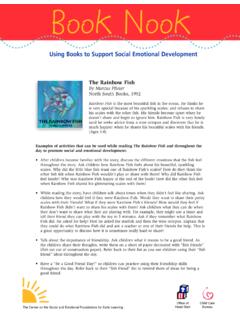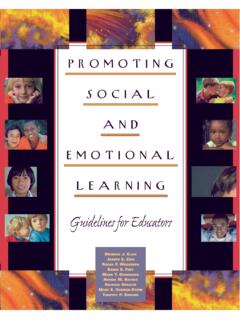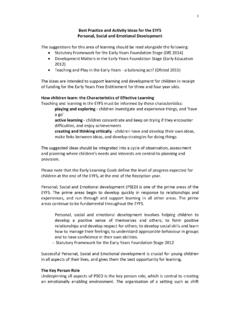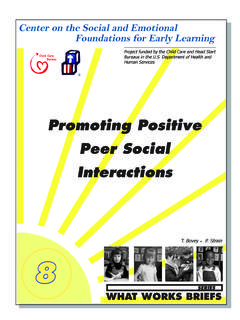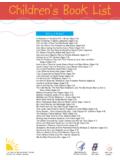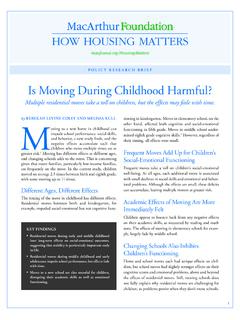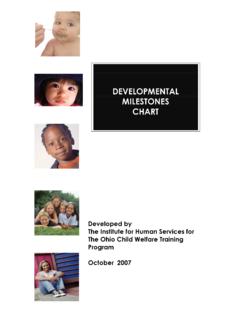Transcription of Including Children with Challenging Behavior in the ...
1 Rutgers, The State University of New Jersey Including Children with Challenging Behavior in the Preschool Classroom Presented by: Michelle Mead & Denise Bouyer-Hargrove Today s Objectives Define Challenging Behavior and its impact. Describe an approach to understand why Children engage in Challenging Behavior . Identify strategies that will decrease Challenging Behavior and improve the quality of life for all Children in the preschool classroom. What is Challenging Behavior ? Persistent pattern of Behavior , or perception of Behavior Interferes with or risk of interfering with Optimal learning Engagement in pro- social interactions Defined on the basis of its effects Manifests in a variety of ways Aggression toward self, others, and things Oppositional Behavior , looks like avoiding tasks, refusal to comply Repetitive movements, activities that distract the child and may appear to have no purpose Dropping to the ground Yelling, screaming, crying, whining Others?
2 ?? Technical Assistance Center on social emotional Intervention for Young Children (TACSEI) Why Behavior Happens? Impact of Challenging Behavior About 1/3 of preschool age Children engage in persistent patterns of Challenging Behavior . Preschool teachers consistently report that one of their biggest concerns is dealing with Challenging Behavior . Rising rates of preschool expulsion Expulsion is 3 times more likely in preschool than grades K 12 Challenging Behavior in early childhood years is predictive of future challenges School failure and lower school attendance Peer rejection Punitive interactions with authority figures Involvement with criminal justice system Technical Assistance Center on social emotional Intervention for Young Children (TACSEI) What Do We Want Children to Do Instead? Build social - emotional skills that have been identified as essential for success in school: Ability to get along with others Follow directions Identify and regulate emotions and Behavior Effectively problem solve to resolve conflict Persist at a task Engage in social conversation and cooperative play Accurately interpret other s emotions and Behavior Positively assess self and others Willingness to try new things Technical Assistance Center on social emotional Intervention for Young Children (TACSEI) What are We Teaching?
3 Challenging Behavior tends to draw more attention It takes attention and time away from those following the rules On average in school settings, the majority of kids are doing the right thing and a few are not There are 10 kids in a class. 7 are sitting in their seats on task. 3 are out of their seats off task. Teacher is focused on getting the 3 kids to sit and do their work. What about the other 7 kids? Increasing Behaviors We Want to See Reinforcement increases desired behaviors Positive reinforcement adds something desirable Praise Tangible rewards ( , stickers) Negative reinforcement takes away something unpleasant Removes an undesirable task/demand Removes an undesirable situation Be very conscious of what behaviors you are reinforcing Shift Toward Prevention: The Best Intervention Taking a proactive, positive approach Emphasis on changing things within our control BEFORE Behavior would typically happen Aspects of the environment Interactions with Children (Are you using the 3:1 rule?)
4 More and better quality attention on the positive behaviors Less reliance on consequences If prevented, it doesn t have to be responded to Redefining Our Roles Including Children with Challenging Behavior in the classroom requires a shift in perspective and practice. See Behavior as an attempt to communicate a message about unmet needs. See Children with Challenging Behavior as in need of being taught skills, not willfully disobedient. See selves as facilitators of social - emotional development, not Behavior managers. Importance of social emotional Screening Use validated screening instruments that can identify strengths as well as possible social - emotional areas of need in infants and toddlers Early identification of young Children with social emotional needs is key Understanding the function of Behavior An Approach to Address Challenging Behavior The CSEFEL Pyramid Model: Promoting social emotional Competence in Infants and Young Children [Assessment-based interventions result in individualized Behavior support plans.]
5 ] All Children Children At-Risk Few Children The Pyramid Model is not a curriculum or intervention; rather, it is a framework for how a program and partitions can operate to support the social emotional needs of all Children (DEC). Universal Tier Promotion of Positive Behavior (CSEFEL) Where Are We? Module 1: social emotional Development within the Context of Relationships Building Positive Relationships social emotional Teaching Strategies Individualized Intensive Interventions 16 Universal Tier Intervention Supports For All Designing Supportive Environments Every child needs 1 person who s crazy about him Uri Bronfenbrenner 17 Building Relationships & Supportive Environments (CSEFEL) Teaching Children Expectations (CSEFEL) 19 Secondary Tier Support for Those at Risk Secondary Tier social emotional Teaching Strategies Skill Teaching (CSEFEL) Friendship Skills Sharing Rationale Describe skill Child has materials Offers or responds to request from peer for materials Demonstrate Right way Wrong way Practice Promote Would it be safe?
6 Would it be fair? How would everyone feel? Problem Solving Steps (CSEFEL) 22 Step 2 Tertiary Tier Intensive Intervention (PBS) Tertiary Tier Promotion of Positive Behavior Individualized and intensive intervention Meant for the few Children who are engaging in persistent patterns of problem Behavior If you have more than 5% of your class who appear to be in need of this level of intervention, then this signifies a need to build up implementation of the 2 prior tiers. Uses the Positive Behavior Support (PBS) approach to understand why Behavior is happening (function) and develop a plan to address it. What is PBS? Comprehensive approach Child centered Mental Health Behavioral Goals To decrease rates of Challenging Behavior To increase quality of life Process Plan environmental supports Assess by doing a Functional Behavior Assessment (FBA) Plan interventions to prevent the Behavior Educate on prosocial skills to meet needs instead of problem Behavior Replace the problem Behavior with consistent practice of new skills and reinforce replacement behaviors CHILD There Are Many Variables to Explore (CSEFEL)
7 Interactions Health Play Learning Environment Instruction Home & Family Outings/Events Friends Toys, Level of play, Opportunities, Choice, Transitions, Cues, Prompts, Supports, Schedules, Room arrangement, Materials, Adaptations, Resources, Routines, Resources, Siblings, Environment, Respite, Predictability, Extended Places family goes, Shared interests & experiences, Trauma, Illness, Stamina, Communication to the child, emotional support, Behavior Basics 27 Antecedents What sets Behavior off Behavior Consequences What pays Behavior off Setting Events Establishing Operations What sets the Behavior up Functional Behavior Assessment (FBA) FBA Team Process Establish observable, measurable definition of the Behavior . Review records to gather a history & awareness of life challenges Change in living situations Change in caregivers Change in health status Exposure to any traumatic events Functional Assessment Interview (FAI) form.
8 Direct observation. Antecedent - Behavior -Consequence (ABC) data Look for patterns in the data to help determine the function When, where, with who the child typically manifests the Behavior What typically happens right before and right after the Behavior What is typically going on when the child isn t engaging in the Challenging Behavior that is working to support positive Behavior Develop a Hypothesis Statement detailing the sequence of elements involved in the Behavior and states the function 30 Something sets me up (setting event) Something sets me off (antecedent) So I ( Behavior ) And I Get/Avoid (consequence) Engaged in preferred activities at home and school With others around Transition times Moved into a smaller home recently. Gave away a lot of things. A child or adult attempts to take me away from something I like and move me onto something else that I don t like. Scream Bite Hit Pinch Everyone backs off and leaves me alone I get to avoid doing something I don t want to do.
9 Function: Attention X - Escape Tangible Sensory Hypothesis Statement Example - Jake Develop a Behavior Support Plan (BSP) Strategies based on the function of the Behavior . Critical elements to include Prevention strategies that address two areas Setting Events Antecedents Skills you will teach that will replace the Challenging Behavior Should meet child s needs (function of Behavior ) Prosocial ways to get that need met Communication Skills, Self-Skills, social Skills Response Plan What do you do when you aren t able to prevent the Challenging Behavior Minimize attention to Challenging Behavior & maintain everyone s safety Everyone in the room needs to know their role with implementing the plan 32 Something sets me up (setting event) Something sets me off (antecedent) So I ( Behavior ) And I Get/Avoid (consequence) Engaged in preferred activities at home and school With others around Transition times Moved into a smaller home recently.
10 Gave away a lot of things. A child or adult attempts to take me away from something I like doing and move onto something else that I don t like. Scream Bite Hit Pinch Everyone backs off and leaves me alone I get to avoid doing something I don t want to do. Function: Attention X - Escape Tangible Sensory Classroom picture schedule. Allow times kids choose activities. Write Jake a social story about his move. Include pics. Lessons (using books, video, discussion) on moving & positive ways to cope. High quality, abundant praise to those following directions. Give choice to bring item from previous activity into new one Guide to an area of classroom where everyone can stay safe. Ex: Calm down space Hypothesis Based BSP Strategies-Jake Use a picture or other nonverbal cue ( , bell) as a signal Provide verbal countdown and/or timer/song to help prepare. Get Jake involved with doing these things.







